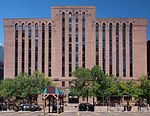Hennepin Energy Recovery Center
The Hennepin Energy Recovery Center also called HERC is a waste-to-energy plant in Minneapolis, Minnesota. Following changes to state law in 1980 that prioritized incinerating garbage over directly filling landfills, HERC was developed and began generating electricity in 1989. Located in the North Loop neighborhood near Target Field, the facility replaced a Greyhound Lines bus maintenance facility. The facility which is owned by Hennepin County, collects almost half of all waste generated in the county. Operation of the facility has been controversial with proposals to burn more trash or close the facility both proposed since 2009. Proposals to burn more trash cite the need to deal with an increasing amount of trash generated and to avoid filling landfills as quickly while proposals to close the facility cite the pollution generated and impact on surrounding neighborhoods. In 2023 the Minnesota state legislature required 100% of electricity in the state to be generated by green energy by 2040 and reclassified waste-to-energy power generation as no longer being considered green. The Hennepin County board voted to develop a plan to close the facility between 2028 and 2040 with activists advocating for an earlier closure.
Excerpt from the Wikipedia article Hennepin Energy Recovery Center (License: CC BY-SA 3.0, Authors).Hennepin Energy Recovery Center
North 7th Street, Minneapolis
Geographical coordinates (GPS) Address Nearby Places Show on map
Geographical coordinates (GPS)
| Latitude | Longitude |
|---|---|
| N 44.9832 ° | E -93.28 ° |
Address
North 7th Street
55411 Minneapolis
Minnesota, United States
Open on Google Maps








